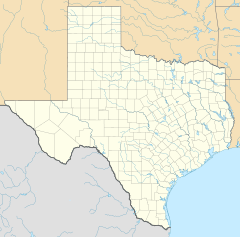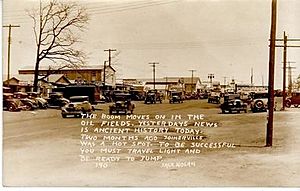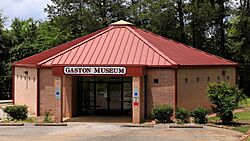Joinerville, Texas facts for kids
Quick facts for kids
Joinerville, Texas
|
|
|---|---|
| Country | United States |
| State | Texas |
| County | Rusk |
| Elevation | 500 ft (200 m) |
| Population
(2000)
|
|
| • Total | 140 |
| Time zone | UTC-6 (Central (CST)) |
| • Summer (DST) | UTC-5 (CDT) |
| ZIP codes |
75658
|
| Area codes | 903, 430 |
Joinerville is a small community in East Texas, United States. It's located in the western part of Rusk County, Texas. This area became famous because of a huge oil discovery in the 1930s.
Joinerville is about seven miles west of Henderson. It had a few different names before. It was first called Cyril, then Miller or Miller Schoolhouse. This was named after Andrew or John Cherry Miller. The community is also close to where an old Cherokee Indian village used to be.
In 1930, the name officially changed to "Joinerville." This was to honor Columbus Marion Joiner. He was the "wildcatter" who found the massive East Texas Oil Field. The dirt road to his discovery well, Daisy Bradford No. 3, crossed the main highway in Joinerville.
Contents
The East Texas Oil Boom
During the exciting oil boom years after 1930, many people came to East Texas. They hoped to find work in the oilfields. Joinerville's population quickly grew to 1,500 people. The community, which was once a quiet farm town, suddenly had 35 businesses. It even got a new post office in 1931.
However, by 1940, the amount of new oil being found started to slow down. The town's population quickly dropped to just 500 people. Over the next ten years, the number of residents kept falling to 350. The number of businesses also went down to only four. After a small increase in the 1950s and 1960s, the population dropped again. From 1980 to 2000, Joinerville had only 140 residents and four businesses.
By 1950, most families who had moved there for oil work left Joinerville. The need to drill new wells was gone. Even though existing oil wells kept pumping, there wasn't enough new work.
In just 20 years, Joinerville went from a tiny spot on the map to a booming town and back again. Most of the old buildings from its busy days are now gone. Today, there are mostly pastures and memories. Joinerville played an important role, not just for Texas, but for the world. This was especially true during World War II. A lot of oil was needed to help the war effort, and East Texas could produce it.
The Gaston School
The Gaston School was built in 1925. It was created by combining two older schools: Miller and Mount Hope. Irene Gaston, a teacher at Mount Hope, gave the land for the new school. It was named Gaston after her and her husband, Hugh.
The school campus was built near the Miller farm. In the 1929-1930 school year, it had four teachers. By the fall of 1931, it had 20 teachers and taught 801 students!
The school was first built for only 80 students. But after oil was discovered and Cyril (Joinerville) grew, it was made much bigger. In 1932, a local newspaper called it "the largest rural school in the world." The rebuilt school had ten buildings, large sports fields, and cool walls made of local rock.
On January 28, 1955, Elvis Presley performed at the Gaston School Auditorium. The high school band sponsored the show. It raised $95 for the band's summer trip.
The Gaston School joined with New London in 1965. They formed the West Rusk County Consolidated Independent School District. The old school buildings are no longer used, but they are still standing today.
Columbus Marion "Dad" Joiner
Early Life and Dreams
Columbus Marion Joiner (1860–1947) was born on a farm in Alabama. When he was five, his father, a soldier, died in the American Civil War.
Joiner later moved to Tennessee. At age 23, he became a lawyer there. He was even elected to the Tennessee state legislature from 1889 to 1891.
In 1897, Joiner moved to Ardmore, Oklahoma, looking for cheap land. By 1906, he owned 12,000 acres of farmland. However, he lost his land during a financial crisis called the Panic of 1907. He then tried to make up his losses by looking for oil in Oklahoma. He drilled his first oil well in 1913. He drilled about 100 wells in total.
In 1926, at 66 years old, Joiner moved to Texas. He believed there was oil in Rusk County, even though geologists told him he was wrong. In 1927, Joiner, then 67, leased thousands of acres of Texas land. He planned to sell shares to raise money. One of these leases was on a 975-acre farm owned by a widow named Daisy Bradford, near Joinerville.
The Daisy Bradford Wells
Joiner and his driller, Tom M. Jones, started drilling the Bradford No. 1 well. It was on an 80-acre piece of land belonging to Daisy Bradford. After drilling for six months, they didn't find oil. The well had to be abandoned because a pipe got stuck.
Joiner didn't give up. On April 14, 1928, he started a new group to raise money. This helped him pay for his second well, the Bradford No. 2. Joiner and driller Bill Osborne started this well 100 feet from the first one.
Joiner's shares were often traded for supplies and labor. People in poor Rusk County used them like money. After drilling on and off for eleven months, the Bradford No. 2 reached a depth of 2,518 feet. But then the drill pipe broke off, blocking the hole.
Some people thought Joiner was a trickster. They said his old drilling equipment, like rusty pipes and a sawmill boiler, was just a prop to fool investors.
The Big Discovery: Daisy Bradford No. 3
On May 8, 1929, driller Ed Laster moved the rig to a new spot. This was 375 feet from the second well. He started drilling the Bradford No. 3.
On September 5, 1930, Joiner and his team made history! No one knew that the largest oil field in the world was right there, untouched, in East Texas. His third well, the "Daisy Bradford No. 3," struck "black gold." It found oil in the Woodbine sand at 3,592 feet deep. The well first produced 300 barrels of oil each day. It was fully ready on October 5, 1930.
The well is located on CR 4136, west of Miller Lake. You can get to it from Texas Highway 64. Today, there's a historical marker at the site. The original well is about 100 feet from the marker and still pumps oil!
H.L. Hunt bought the original well from "Dad" Joiner in November 1930. Hunt Oil owned it until 2014.
Legal Troubles and Retirement
Soon after finding oil with the Daisy Bradford #3, Joiner got into legal trouble. He had sold too many shares in his oil project. Just two months after his big discovery, he had to sell his oil holdings. Haroldson L. "H.L" Hunt of Hunt Oil bought them for $1.34 million. After 1940, Joiner retired to Dallas.
The Huge East Texas Oilfield
By early 1931, it became clear that the new oil wells in the area were not small, separate pockets of oil. Instead, they were all part of one giant field. This field stretched for dozens of miles! All the new wells were getting oil from the same Woodbine sands.
This huge East Texas Oilfield covered parts of Smith, Upshur, Gregg, Cherokee, and Rusk counties. It eventually had 30,340 oil wells, both old and active. It was about 45 miles long (north to south) and 5 miles wide. At the time, it became the largest oil field in the U.S. outside of Alaska.
So much drilling led to too much oil being produced. Oil prices crashed from $1.10 a barrel in 1930 to just 10 cents a barrel in 1931. This flood of oil hurt the U.S. oil market and the world economy. It made the Great Depression even worse. In August 1931, the oil drillers in East Texas were out of control. So, the Governor of Texas ordered the National Guard to the oil fields to restore order. Later, laws were made to control oil production and stabilize the market.
The East Texas Oilfield became even more important during World War II. A 1,400-mile pipeline called "Big Inch" was built from Texas to refineries in Pennsylvania. This pipeline was key to giving Allied troops plenty of petroleum products.
Today, the East Texas Oilfield, found near Joinerville, is still the largest oilfield in the United States, not counting Alaska.
Gaston Museum
The Gaston Museum is located in Joinerville, Texas. It shows what life was like in the East Texas Oil Field from the 1930s to the 1960s. The museum's main building opened in June 2005. It has the only known surviving "Tent House." Visitors can step back in time and see how people lived during the 1930 oil boom.
The Gaston Museum has many cool things from the boom era. These include family histories, an old radio display, and original equipment from a 1930s radio repair shop. It also has items from the Gaston School, local businesses, and churches. There's even a "wall of honor" for local veterans.
The Daisy Bradford #3, the well that discovered the East Texas Oil Field, is only 2.2 miles from the museum.
Notable People
- Charlie Waller, a bluegrass musician, was born in Joinerville.
- Adrian Burk, a football quarterback, went to school in Joinerville.






